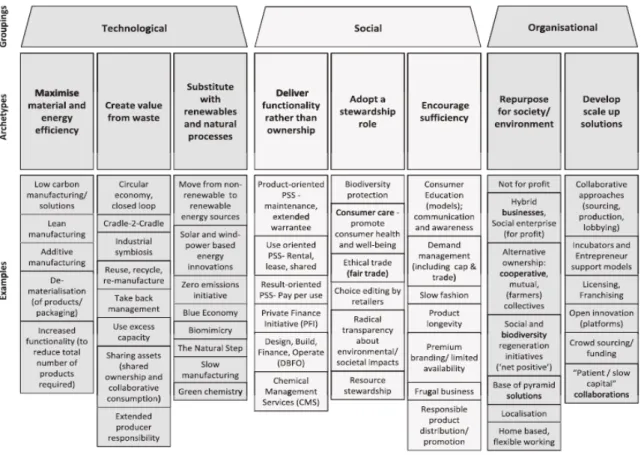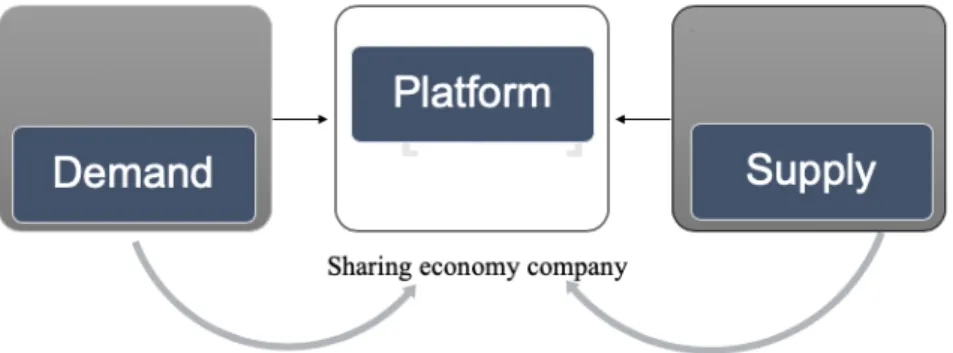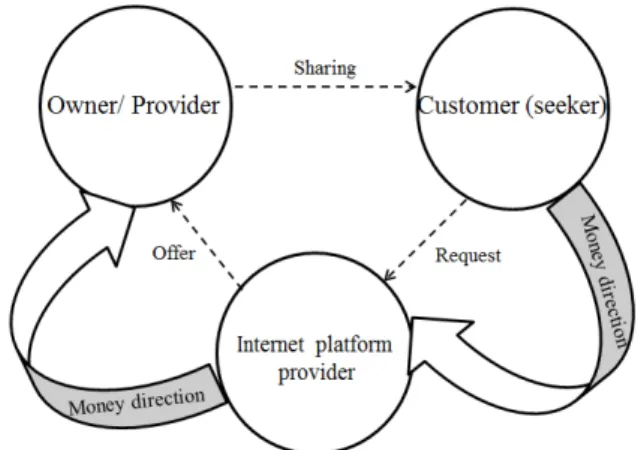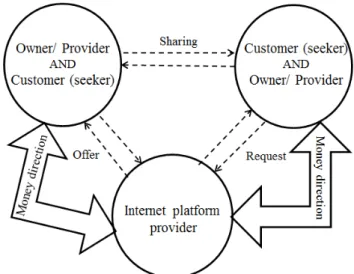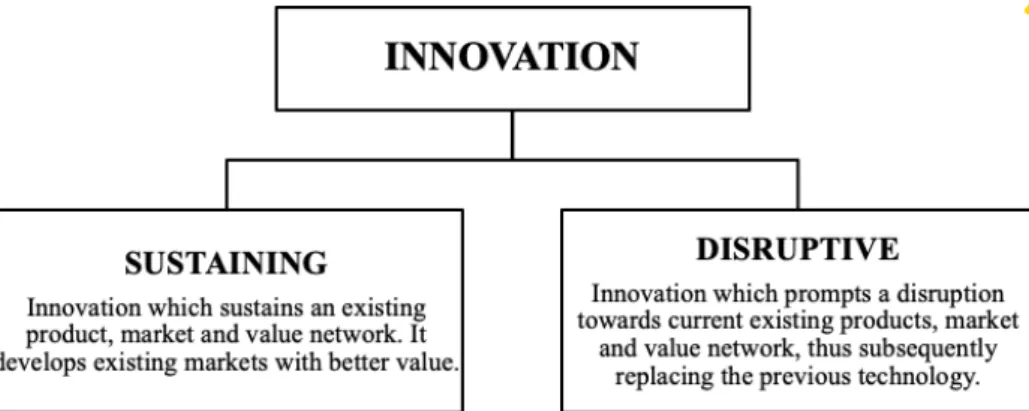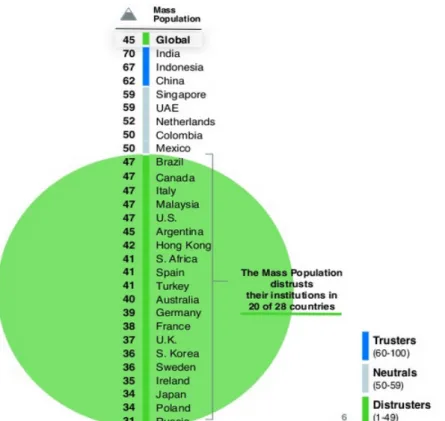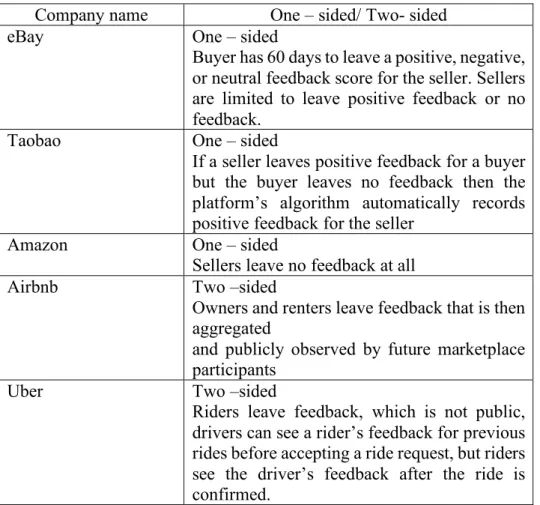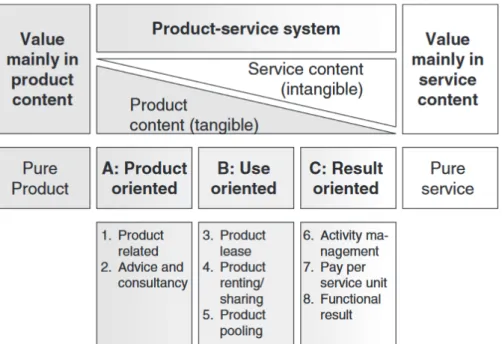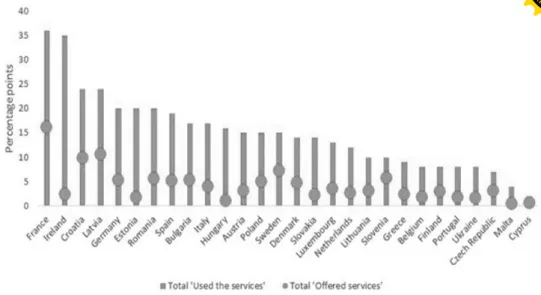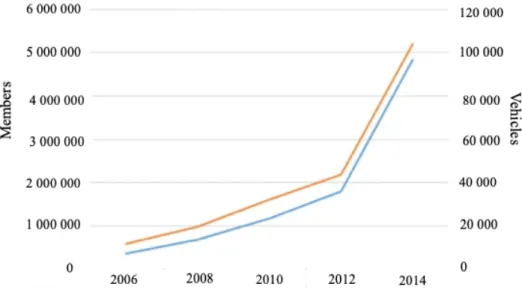1
DOCTORAL (PhD) DISSERTATION
GÖRÖG GEORGINA
2019
Click to BUY NOW!
.tracker-software.c Click to BUY NOW!
.tracker-software.c
2
KAPOSVÁR UNIVERSITY
DOCTORAL SCHOOL OF MANAGEMENT AND ORGANIZATIONAL SCIENCES
Head of Doctoral School Prof. FERTŐ IMRE DSc
Doctor of the Hungarian Academy of Sciences
Supervisor
Prof. emeritus KEREKES SÁNDOR DSc Doctor of the Hungarian Academy of Sciences
Co - Supervisor Prof. TÓZSA ISTVÁN
SHARING ECONOMY IN THE CONTEXT OF SUSTAINABLE DEVELOPMENT -
THE EMPIRICAL EXAMINATION OF THE ACCOMMODATION SHARING
by
GÖRÖG GEORGINA
KAPOSVÁR 2019
DOI: 10.17166/KE2020.005
Click to BUY NOW!
.tracker-software.c Click to BUY NOW!
.tracker-software.c
3
Dedicated to my Mum and Dad for their unconditional love, endless support and encouragement
Click to BUY NOW!
.tracker-software.c Click to BUY NOW!
.tracker-software.c
4 Table of Contents
Table of Figures ... 6 List of Tables ... 7 INTRODUCTION ... 8 THE GOAL OF THE DISSERTATION. RESEARCH QUESTIONS AND HYPOTHESES ... 10 1. THE SHARING ECONOMY: THE NEW ECONOMIC SYSTEM 14 1.1. From sharing to the sharing economy: the emergence of the new economy ... 14 1.2. The sharing economy as new business model ... 18 1.3. The sharing economy as disruptive innovation ... 26 1.4. The sharing economy as the new trust system: the reborn of trust and the role of the online review system... 30 1.5. Core categories: Redistributing markets, product-service systems (PSS) and collaborative lifestyle ... 39 2. SUSTAINABILITY ELEMENTS OF THE SHARING ECONOMY
44
2.1. The sharing economy from users and legal perspective: the main reasons of its popularity and arguments against it ... 44 2.2. Potential outcomes: pathway to sustainability or a new form of neoliberalism? (Chris J. Martin, 2016) ... 54 2.3. The environmental, social and economic impacts of the sharing economy ... 56 2.4. Sustainable Development in practice? The sharing economy and the Sustainable Development Goals ... 64 3. THE ACCOMMODATION SHARING AND ITS IMPACT ON PROPERTY MARKET AND HOTEL INDUSTRY ... 68 3.1. The expansion of the short-term accommodation rentals: its
benefits and drawbacks ... 68 3.2. Housing market in Europe and in Hungary ... 72 3.3. Previous studies about short-term accommodation sharing, its consequences and city level regulations ... 76
Click to BUY NOW!
.tracker-software.c Click to BUY NOW!
.tracker-software.c
5
4. EMPIRICAL RESEARCH: THE EXAMINATION OF THE
ACCOMMODATION SHARING ... 80
4.1. Dataset and methodology ... 84
4.2. Results (1): Correlation Analysis in case of Airbnb market... 93
4.3. Results (2): Examination of Airbnb supply with panel data regression ...106
4.4. Results (3): Stepwise regression analysis in case of entire homes and shared rooms ...115
4.5. Results (4): Examination of belonging to Eurozone and Airbnb regulation by nominal by interval relationship ...118
4.6. Conclusion and discussion ...120
5. NEW SCIENTIFIC RESULTS ...127
6. SUMMARY ...129
ACKNOWLEDGEMENT ...131
REFERENCES ...132
LIST OF AUTHORS’ PUBLICATIONS IN THE FIELD OF THE DISSERTATION...154
LIST OF AUTHORS’ PUBLICATIONS OUT OF THE FIELD OF THE DISSERTATION...156
CURRICULUM VITAE ...158
ANNEXES ...159
Click to BUY NOW!
.tracker-software.c Click to BUY NOW!
.tracker-software.c
6 Table of Figures
Figure 1 The sustainable business model archetypes (Source: Bocken et al. 2014: 48) ... 22 Figure 2 Structure of a peer-to-peer model (Source: Demary, 2015) ... 23 Figure 3 Sharing economy model triangle (Source: own elaboration based on Benoit et al., 2017; Grybaitė and Stankevičienė, 2016) ... 24 Figure 4 Expanded Sharing economy model triangle (own elaboration) 25 Figure 5 Two types of innovation (Source: based on Christensen cited by Rahman et al. 2017) ... 27 Figure 6 2/3 of the respondent countries are distruster (Source: Edelman Trust Barometer, 2017) ... 32 Figure 7 Types of product-service system (Source: Tukker, 2004: 248) 42 Figure 8 Share of Europeans who use Sharing Economy platforms
(Source: Winkler, 2017) ... 45 Figure 9 Growing number of members and vehicles in case car sharing (Source: Shaheen, 2015.) ... 57 Figure 10 Growing number of listings on Airbnb (Source: Airbnb.com) 58 Figure 11 Distribution of home buyers in Budapest by the purpose of home purchase (Source: MNB, 2018) ... 71 Figure 12 Multi-listing home owners on Airbnb: numbers in brackets mean the number of managed properties; numbers on the right side mean the revenue in $ million (Source: The Telegraph, AIRDNA) ... 72 Figure 13 Share of population living in owner-occupied dwellings in the EU member states, 2016 (%) (Source: EUROSTAT) ... 73 Figure 14 Average monthly rental cost development in case of an... 74 Figure 15 The distribution of Airbnb accommodations in Budapest
(purple dots shows the entire homes and blue dots indicates the private rooms) (Source: AirDNA)... 75 Figure 16 The share of multi-listing hosts (%) (Source: AirDNA, 2018, own elaboration) ... 99
Click to BUY NOW!
.tracker-software.c Click to BUY NOW!
.tracker-software.c
7 List of Tables
Table 1 Types of review system in different online marketplaces (Source:
own elaboration based on Tadelis, 2017) ... 35 Table 2 Benefits of the sharing economy (Own elaboration based on Grybaitė and Stankeviciene, 2016) ... 61 Table 3 Regulatory responses to Airbnb in various cities (Source:
Shabrina et al. 2017: 7-8) ... 78 Table 4 Hypotheses of the dissertation (own elaboration) ... 82 Table 5 List of the examined cities (own elaboration) ... 84 Table 6 Characteristics of the short-term accommodation sharing - list of employed variables (own collection) ... 86 Table 7 Selected variables in my research models (own collection) ... 88 Table 8 Hypothesis of the Hausman test (Source: Tarnóczi et al. 2015) . 92 Table 9 Descriptive statistics of the share of the available accommodation types (data in %) (own collection) ... 94 Table 10 Pearson correlations - available accommodation types (N=45) (own elaboration) ... 97 Table 11 Pearson correlations - share of multi-listing hosts (N=45) (own elaboration) ...101 Table 12 Pearson correlations - number of booked accommodations (N=45) (own elaboration) ...103 Table 13 Testing for Multicollinearity with Variance Inflation Factors (VIF) 1 (own elaboration) ...108 Table 14 Testing for Multicollinearity with Variance Inflation Factors (VIF) 2 (own elaboration) ...109 Table 15 Coefficients of Hausman test (own elaboration) ...111 Table 16 Results of panel data regression (own elaboration) ...114 Table 17 Descriptive statistics of panel data regression (own elaboration) ...115 Table 18 Results of Stepwise regression, forward selection: Entire homes (own elaboration) ...117 Table 19 Results of Stepwise regression, forward selection: Private rooms (own elaboration) ...118 Table 20 Results of nominal by interval relationship in case of Eurozone (own elaboration) ...119 Table 21 Results of nominal by interval relationship in case of Airbnb regulation (own elaboration) ...120 Table 22 Results of the hypothesis analysis (own elaboration) ...122
Click to BUY NOW!
.tracker-software.c Click to BUY NOW!
.tracker-software.c
8 INTRODUCTION
Considering the global issues, one of our biggest challenges is to find a sustainable, long-term working system which is good for society, the environment and the economy as well. Heinrichs states that “despite the success of some environmental and sustainability initiatives and measures in policy-making, business and society, overall trends follow an unsustainable path” (Heinrichs, 2013. p.228). From this perspective, a positive picture of a fair, trustworthy, low-carbon economy which is more transparent sounds promising, so the sharing economy, also called collaborative economy or access economy or connected consumption; in other words, a more collaborative approach to the exchange of goods and services can be a possible solution.
The main aim of this dissertation is to examine the accommodation sharing, the biggest sharing economy service sector (Vaughan and Hawksworth, 2014), from sustainable development perspective.
At the beginning of my research, I was reluctant to believe that the sharing economy can contribute to sustainable development, because my friends and acquaintances had a good and bad experience with UBER and Airbnb, and I simply assumed these are new and cheaper forms of travelling and short-term accommodation. However, I started to dig into the sharing economy literature and while I was getting more and more familiar with the concept, I recognized that the idea and model of the sharing economy could enhance long-term sustainability. The research area came from my personal experience as well; I like travelling and I had the opportunity to try Airbnb in different cities and I collected various experience with this accommodation sharing platform. For instance, the first case was when I was in Malaga where our rented room was in an apartment where the
Click to BUY NOW!
.tracker-software.c Click to BUY NOW!
.tracker-software.c
9
owner-family lived, and they shared their home with us. We used the same kitchen and bathroom, they gave us information about sightseeing, restaurants and so on. This experience was really local and quite personal.
On the contrary, other case happened in Paphos, where after we confirmed the booking, it turned out that we rented an apartment from a company who builds its business to this new economic system: they have more than 10 flats that they advertise on Airbnb and we did not even meet the company representative (or our host); we could get in the flat with the help of a smart lock. Consequently, the question came up: where is the personal experience and community building? If more and more entire apartments are used for short-term accommodation purposes, how does it affect local markets and communities? Considering this question and exploring the accommodation situation in the bigger cities (where the accommodation sale and renting prices getting higher and higher), my main research question is: does the accommodation sharing in its current form contribute to sustainable development? Does it enhance the fulfilment of sustainable development goals? If so, that should be welcomed, and promoted; if not how can the current system be changed? I believe that we do have a theoretically good, new economic system that can contribute to the strong sustainability and I find really exciting to examine how it works in practice.
Click to BUY NOW!
.tracker-software.c Click to BUY NOW!
.tracker-software.c
10
THE GOAL OF THE DISSERTATION. RESEARCH QUESTIONS AND HYPOTHESES
According to several authors, the model which brings economic interests in line with positive environmental and social impacts, the sharing economy has been considered a promising pattern towards more sustainable economy (Cohen and Kietzmann, 2014; Curtis and Lehner, 2019; Heinrichs, 2013). However, other researchers declare that sharing is not caring: it is a growing network of unregulated digital marketplaces and it creates unfair competition (Ranchordás, 2015; Martin, 2016, Schor, 2017). My research assumes that the concept of the sharing economy supports sustainable development theoretically; however, accommodation sharing is only a new and rebranded form of the old economy.
In the first part of my examination, I introduce the sharing economy as a new economic system then in the following chapter I analyse the sustainability elements of the collaborative or sharing economy. The next part deals with the housing market in Europe and the accommodation sharing along with its real and potential consequences on the long-term accommodation renting market.
Several studies examine the sharing economy from users’ perspective (eg.
Havas, 2014; Nielsen, 2014, Hamari et al., 2015) but I find interesting to study this from the supply side as well. Therefore, in my empirical research, I focus on Airbnb, the biggest accommodation sharing platform, and I investigate the characteristics of Airbnb accommodations in 45 European cities.
Initially, Airbnb was used by hosts offering cheap bed and breakfast in their permanent homes for travellers for a short period of time (The Economist, 2013a). Local communities can benefit from this idea or business model of
Click to BUY NOW!
.tracker-software.c Click to BUY NOW!
.tracker-software.c
11
such non-professional, peer-to-peer service by earning income from their unused space also supporting local small businesses (Gyódy, 2019).
Furthermore, using Airbnb can contribute to decreasing the feeling of loneliness in case of people who live alone by enabling them to be hosts in this new business and accommodate guests in their houses.
However; this trend has changed, and an only small part of Airbnb listings can be categorized as traditional sharing economy services and bigger share of listings represent professional and commercial offers on the platform (Gyódy, 2019) with its all negative consequences. Various negative outcomes can be identified: accommodation sharing will be attractive among property investors for the purpose of providing business- to-consumer services. Consequently, it can enhance the gentrification of popular tourist areas (Gutiérrez et al., 2017). If hosts prefer the short-term rentals over long-term rentals, the supply of available accommodations is reduced which can contribute to the higher rental prices and it could potentially affect the domestic rental market and the quality life of residents as well.
My research concentrates on the relevant and selected Sustainable Development Goals (SDGs). In this context, the relevant refers to SDG’s that Airbnb has a direct effect on via local communities, such as Reducing Inequality or Sustainable Cities and Communities or Decent Work and Economic Growth. I do not exclude environmental and social factors of sustainable development; however, in my empirical research the main focus is on economic factors and I examine Airbnb from an economic perspective.
Click to BUY NOW!
.tracker-software.c Click to BUY NOW!
.tracker-software.c
12
In my dissertation I would like to answer the following research questions:
• How does the new economic system shake up the traditional markets? What is its novelty and disruptive effect?
• Does accommodation sharing contribute to the fulfilment of the relevant Sustainable Development Goals?
o Are there regional differences between the poorer and richer regions in Europe on the Airbnb market?
o Which factors do influence the number of listings on Airbnb? How does the change in GDP or change in unemployment rate influence the number of available listings?
Do changes in hotel room supply influence Airbnb supply?
o Does the housing situation (such as tenure status: owning or renting a property and average size of dwelling) have an effect on Airbnb market? Who do rent out their apartments: the owners or the tenants? Is the bigger the dwelling the higher chance to rent it out?
• How can we describe the accommodation sharing in its current operation: sustainable lifestyle or new form of the neoliberal economy?
At the beginning of my research I formulated the hypotheses that I would like to test during my examination:
• We can identify regional differences on Airbnb market in Europe. I assume that GDP is negatively associated with Airbnb supply and GDP and income are negatively correlated with the share of multi-listing hosts (I measure the share of professional hosts with the number of multi-listing hosts). Also, I expect that
Click to BUY NOW!
.tracker-software.c Click to BUY NOW!
.tracker-software.c
13
belonging to Eurozone affects significantly the number of booked Airbnb accommodations, the number of multi-listing hosts and the Airbnb supply.
• Changes in economic and market conditions have a strong impact on Airbnb penetration. I assume that there is a strong correlation between the income of households and unemployment rate and Airbnb supply: income is negatively, and unemployment is positively associated with the number of available accommodations on Airbnb. Furthermore, I assume that short-term accommodation market regulation strongly affects the Airbnb supply.
• The effect of increasing tourism is more significant in case of available Airbnb entire home supply than private room supply.
All Airbnb accommodation types (entire home, private room, shared room) significantly correlate with the number of hotel rooms and the strongest correlation can be observed between entire homes and the number of hotel rooms. The number of hotel rooms is positively associated with available Airbnb supply.
• The housing situation (such as tenure status: owning or renting a property and average size of dwelling) significantly affects Airbnb market. I assume that there is a correlation between the average dwelling size and the number of available short-term accommodations: the higher the dwelling size is the stronger correlation with Airbnb supply. If the host has a bigger house or apartment there is a higher chance it is rented out via Airbnb. Also, I expect that the ownership structure correlates the Airbnb supply:
changes in the ownership structure cause change in the Airbnb supply.
Click to BUY NOW!
.tracker-software.c Click to BUY NOW!
.tracker-software.c
14
1. THE SHARING ECONOMY: THE NEW ECONOMIC SYSTEM
1.1. From sharing to the sharing economy: the emergence of the new economy
According to a comprehensive description, sharing economy, also called collaborative economy or access economy or connected consumption, is an expression for the emerging type of business models, platforms and exchanges (Allen and Berg, 2014) where people share their intangible assets and underutilized tangible assets for money or for free with the help of the Internet (Cohen and Munoz, 2016). Looking at its popularity nowadays, sharing economy looks like a brand-new economy; however, the concept of “sharing” is not new. The practice of sharing has a long- time history; If we search for the meaning and origin of the word, according to the Oxford Dictionary ‘share’ can be a noun and a verb too.
Share as a noun means “a part or portion of a larger amount which is divided among a number of people or to which a number of people contribute”. Share as a verb refers to “have a portion of (something) with another or others”. The verb dates from the late 16th century and origins from the old English word ‘scearu – division, part into which something may be divided’ of German origin; related to Dutch word ‘schare’ (Oxford Dictionary, 2018). People shared their goods with their family members, friends, neighbours or trusted social contacts since they started to live in communities (Belk 2014b; Schor 2014). Not only in prehistoric times but also in the late history there is evidence of sharing which proves that this is not a brand-new concept. For instance, in Germany in the late 19th century, in search of work and better living conditions people moved from the countryside to the cities. The local people and city administrations helped
Click to BUY NOW!
.tracker-software.c Click to BUY NOW!
.tracker-software.c
15
them with open spaces and land where they could grow their own food.
This was the early sign of community gardens (Abele, M. et al. 2015).
Another example is when in the middle of the 20th century the US government encouraged ride sharing to conserve resources. In 1948, car sharing was launched in Zurich and it was very popular especially in the 1980s and was operated mainly by small community-based non-profit organisations (Shaheen et al., 1999). Together, these cases outline that during our history, people have shared, borrowed, lent, leased, rented, swapped and donated goods, services and time (Piscicelli, 2016). In agreement with this, Belk (2014a) says that the practice of sharing is as old as humankind, however, the collaborative consumption and sharing economy was born thanks to the Internet. To summarize, sharing has always been part of the cooperation; also, it could bring people together and inspire social cohesion in neighbourhoods (Agyeman & McLaren, 2015). Although Schor (2014) agrees with these statements, she adds that there is something new about the sharing economy, which is so-called
“stranger sharing”, she explains that this factor is why sharing economy is being considered a novelty.
Generally speaking about the new market, eBay is the first online marketplace, that can be considered as a sharing economy predecessor (Sundararajan, 2016), where people can buy and swap goods. It was launched in 1995. eBay enhances the circulation of goods in the market and people get it and change it with the help of the internet (eBay, 2017). At that time eBay was a totally brand-new form of marketplace.
In early 2000, Internet became more popular and due to the accelerated technology, businesses started to link the online and offline world resulting that the sharing economy is one of these initiatives (Botsman and Rogers, 2010). In their seminal book ‘What’s Mine Is Yours: How Collaborative
Click to BUY NOW!
.tracker-software.c Click to BUY NOW!
.tracker-software.c
16
Consumption is Changing the Way We Live’ introduce the new type of marketplace, the concept of shared social and economic activity as well as the meaning of the collaborative consumption. They demonstrate that people ‘make the things they owned available to others’ (Stokes et al., 2014:30).
Our society is built on the hyper-consumption, we have a lot of goods in our homes that we do not use every day; moreover, we have products that have been used only once. In her TED presentation, Botsman (2010) asks the audience: how many of you have a power drill, own a power drill? The power drill is a typical case of the possible product sharing because it is being used around 12 to 13 minutes in its entire lifetime and our need is the hole, not the drill. During their research, they examined several businesses and identified the different categories of the collaborative consumption businesses, the main drivers as well as the key principles which are essential to making the sharing economy or collaborative consumption work (Botsman and Rogers, 2010).
In 2010, Lisa Gansky also published a book about the sharing economy.
She calls this phenomenon ‘mesh’ and ‘mesh economy’. She explains that there is a fundamental shift in our relationship with stuff, with the things in our lives (Gansky, 2010a) and says that definition of ‘the mesh’ is like the sharing economy. Likewise, to Botsman and Rogers (2010), she identified the characteristics of mesh businesses: they have physical goods that can be shared, they use the internet and mobile technology to execute the business as well as they rely on word-of-mouth and social networks (Gansky, 2010a). Above all, she stresses the new value creation by sharing using information technology (Gansky, 2010b).
Click to BUY NOW!
.tracker-software.c Click to BUY NOW!
.tracker-software.c
17
Sundararajan (2016) joins this discussion and he highlights the innovative business model aspects of the sharing economy, namely how the underutilised products and resources can create economic value.
Rifkin argues that “sharing economy is the third industrial revolution”
(Rifkin, 2011:1) and he states that the desire to “access” from “own” keeps growing in case of most of the services (Rifkin, 2011). Sundararajan and Rifkin, both are taking the sharing economy into consideration from the current capitalism point of view. They predict different scenarios, while Rifkin argues that the capitalism will be destroyed by the sharing economy (Rifkin, 2014), Sundararajan (2016) refers to a new form of capitalism which is crowd-based capitalism where a new type of regulations, jobs and social fabric will be born.
Codagnone and Martens (2016) approach this new market from various perspectives and they identify three main basic areas in connection with the sharing economy: (1) sociological approach; it focuses on the changing role of individuals, the more conscious and responsible consumer behaviour and the growing altruistic mentality. (2) Economics approach;
in this meaning, the sharing economy has a positive effect on innovation and stimulates the competition. (3) Management theories: it refers to the emergence of new business models and a new type of entrepreneurship; it is a service provider approach that may enhance the reformation of the traditional industries (Codagnone and Martens 2016; cited by Jancsik et al.
2018).
In the business world, the whole sharing economy concept became well- known between 2011 and 2012 with the success stories of Airbnb and UBER (Martin, 2016). Since then, all relevant business journal published articles about the new concept; in 2011, when the idea first became widely recognized, TIME Magazine announced that the sharing economy is one of
Click to BUY NOW!
.tracker-software.c Click to BUY NOW!
.tracker-software.c
18
the “Ten Ideas That Will Change the World” (Time.com, 2011). Later, in the same journal the leading article was about collaborative consumption (Time.com, 2015). In 2013, Economist published a full volume about this topic (The Economist, 2013a,b) that was followed by Forbes (2013) magazine as well.
In the same time, the conversation on the sharing economy was lagging behind in terms of public discourse and practice in the academic world (Heinrichs, 2013:229). Since then several publications and research papers have been published about the sharing economy: there are lots of articles about its business opportunity, (e.g. Daunorienė et al. 2015; Habibi et al.
2016; Wallenstein & Shelat, 2017) its impact on tourism industry (e.g.
Zervas et al. 2017; Fang et al. 2016), its relationship with trust and reputation (e.g. Koopman et al. 2015; Ert et al 2016; Hawlitschek et. al 2016; Möhlmann, 2016), its regulatory issues (e.g. Cannon et al. 2014;
Koopman et al. 2015; Malhotra and Van Alstyne, 2014; Sundararajan, 2016; Ranchordás, 2015), the motivation factors for participation (e.g.
Kim et al. 2015; Hamari et al. 2015; Möhlmann, 2015), its impact on employment (e.g. Sundararajan, 2016; Bouncken & Reuschl, 2018); as well as its impact on discrimination (e.g. Edelman et al. 2017; Cheng and Foley, 2018).
1.2. The sharing economy as a new business model
Nowadays, it is being said that developed countries have a service economy (Nádasy-Kerekes-Luda, 2010.). The service economy defined as if more than half of the total workforce is employed by the service sector (Mont, 2002.). In highly industrialized countries roughly 70% of the workers are employed by this service sector: telecommunication,
Click to BUY NOW!
.tracker-software.c Click to BUY NOW!
.tracker-software.c
19
transportation, information technology, financial services and so on. This new and modern economic form enhances innovation, improved design and quality contributing towards sustainable consumption. The service economy, in other words, functional economy, refers to the phenomenon when the customer buys the service provided by the product instead of the product itself because he requires mobility, not the vehicle or clean clothes, not the washing machine (Nádasy-Kerekes-Luda, 2010.) Stahel (1988) proposed the concept of the service society as a tool of achieving sustainable development. He advised distinguishing the industrial economy and service-oriented economy. With the functional economy, it became clear that it is not necessary to cling on to the current unsustainable level of mass production, we need to develop a new model which is based on less consumption and the reusing of product. Consequently, the human need is not to own goods, our need is services provided by these products, so we are moving from the stock economy towards the flow economy (Nádasy-Kerekes-Luda, 2010.). Over the past years, several business models were born which support this view (Tukker, 2015) and the message is similar; modern economies need business models which helps society and they do not need to own products because they have a need for the services (Cohen and Kietzmann, 2014).
Over the last decade, internet-based companies have created a new and innovative business model (Chesbrough, 2010). Osterwalder and Pigneur (2010) define a business model as something that “describes the rationale of how an organisation creates, delivers, and captures value” (Osterwalder and Pigneur, 2010, p 14). Based on this statement, the business model is a business strategy translated into a framework to create economic value.
This is a strategic management tool, which is widely used to analyse the strategic positioning of a company (Osterwalder, 2004). Sommer (2012, p.
Click to BUY NOW!
.tracker-software.c Click to BUY NOW!
.tracker-software.c
20
4) defines that a business model can be defined as “a blueprint of the value proposition offered to the customer, the way the business creates and delivers that value and extracts profits from it”. Planing (2018) argues that the two main types of business model orientation are product or service- oriented business model. He adds that another main difference between business models is the business model for business-to-consumer markets or for business-to-business markets. Additionally, business models can be differentiated based on their income models; revenue can be generated by selling, lending or licensing the product or service (Planing, 2018).
Sustainable business models create value in the way which is good our society, environment and economy. In his article, Zilahy (2016) introduces different business models with their potential benefits to the environment and society as well. These groups were originally identified by SustainAbilty, an advisory company and they are classified into five groups:
1. Business models with potentially positive impact on the environment 2. Business models aiming at social innovation
3. Base of the pyramid business models 4. Innovative financing models
5. Business models with diverse impacts on sustainability (Zilahy, 2016:70).
In a broader sense, Bocken et al. (2014) identified the sustainable business model archetypes. These models have three main groups: technological, social and archaeological. Within these classes are the archetypes which are: Maximise material and energy efficiency; Create value from ‘waste’;
Substitute with renewables and natural processes; Deliver functionality rather than ownership; Adopt a stewardship role; Encourage sufficiency;
Re-purpose the business for society/environment; and Develop scale-up
Click to BUY NOW!
.tracker-software.c Click to BUY NOW!
.tracker-software.c
21
solutions (Fig 1). Figure 1 shows that more sustainable business model archetypes contain various elements of the sharing economy.
In their paper, Kocsis and Harangozó (2018) analyse the main alternatives of traditional economic growth from the sustainable future point of view.
They identified the ‘negative growth’ or ‘degrowth’, ‘zero growth’ and
‘positive growth’ as possible ways to overcome the sustainability crisis and draw up options and actions how these could be reached. In case of
‘degrowth’ they introduce the sharing economy as a profit-taking alternative for firms because companies can generate revenue without producing new product or consume more energy.
Over the last years, several business models were born which are innovative and promising from the long-term sustainability point of view;
however, most of them could not reach the critical mass. More and more organizations should recognize the importance of sustainable development and change their operation or at least implement sustainable commitments.
Click to BUY NOW!
.tracker-software.c Click to BUY NOW!
.tracker-software.c
22
Figure 1 The sustainable business model archetypes (Source: Bocken et al. 2014: 48)
Click to BUY NOW!
.tracker-software.c Click to BUY NOW!
.tracker-software.c
23
Looking at the operating model of some well-known sharing economy companies, UBER has no car but it is the world’s largest taxi company.
Airbnb has no real estate but it is the largest accommodation provider.
Netflix, the largest movie house, has no cinemas and the large phone companies have no telecommunication infrastructure (Fruman, 2016).
Sharing economy companies represent something new which is totally different from the ‘classic economy’. The sharing economy concept is described as an economic model based on “sharing underutilized assets, skills, things, financial or non-financial benefits” (Botsman, 2013 p 6, Lessig, 2008). If we examine the operation of the sharing economy business, it can be realized that the basic model in the sharing economy is slightly dissimilar to the traditional business model. The Sharing Economy business models are usually platform-based where supply and demand can meet (Demary, 2015). One huge advantage of the sharing economy business is the fact of low barrier to entry, namely the platform companies without any assets or strong financial background can easily be established and the services for users can be reached quickly and cheaper way. To run a successful business, platform owners don’t have to have or produce goods and services, they must provide the connection and communication between supply and demand.
Figure 2 Structure of a peer-to-peer model (Source: Demary, 2015)
Click to BUY NOW!
.tracker-software.c Click to BUY NOW!
.tracker-software.c
24
Looking at the sharing economy companies, the platform can be accessed globally, the service can be reached locally: for example, in case of peer- to-peer car sharing (eg. UBER), shared travel service can be found worldwide (platform) but drivers (supply) provide service for passengers (demand) locally. Consequently, the peer-to-peer local supply and demand can meet with help of global platform (Fig 2). The platform provider matches local demand and supply in various markets, so the scale of the operation is huge (Demary, 2015).
This new model exists within a triangle of actors: a platform provider, a peer service provider and a customer/seeker (Benoit et al., 2017) as shown in Fig 3.
Figure 3 Sharing economy model triangle (Source: own elaboration based on Benoit et al., 2017; Grybaitė and Stankevičienė, 2016) Considering its operation as Fig 4 shows, the buyers can be sellers and reverse as well, so the role of the customer can change. (Not only sellers, but also buyers can sell their products/services on the online marketplace and sellers also can be buyers.)
Click to BUY NOW!
.tracker-software.c Click to BUY NOW!
.tracker-software.c
25
Figure 4 Expanded Sharing economy model triangle (own elaboration) In case of the base type, a company (internet platform provider) creates peer-to-peer platforms connecting providers and users (customers/seekers) for the exchange, purchase or renting of goods and services (Rauch and Scleicher, 2015). With the help of online platforms, customers can reach the sellers directly without any intermediaries. In this type, the platform provider is an independent, third-party actor.
In order to create and deliver value, a company might need to collaborate with other participants in the industry or society (Osterwalder, 2004;
Sommer, 2012.). A corporation needs to decide whether resources should be produced internally or by an external party. This relationship is often described as transaction cost theory (Henten and Windekilde, 2016). The theory indicates that partnerships with participants outside the company will result in an increased focus on the company’s core competencies (Williamson, 1979). Considering the difference between the operation of
Click to BUY NOW!
.tracker-software.c Click to BUY NOW!
.tracker-software.c
26
the traditional business and the sharing economy, the lower transaction cost is one of the biggest advantages of the sharing economy companies.
1.3. The sharing economy as disruptive innovation According to Richardson (2015) the sharing economy is able to change and disrupt the ‘business-as-usual’. Although, several authors declare that the sharing economy is disruptive innovation because it has shaken up the markets and could transform market economies (Demary, 2015; Guttentag, 2013; Martin, 2016.; Dudley et al., 2017), others say that sharing economy in most cases is not disruptive innovation (Bailey, 2017; Roy, 2018).
Generally speaking, in recent years innovation itself became a buzzword due to the fact that we tend to use it for many different things regardless of its real meaning. Australian Government says that “Innovation generally refers to changing processes or creating more effective processes, products and ideas…innovation can mean changing your business model and adapting to changes in your environment to deliver better products or services” (2017). Schumpeter (1934) categorizes five types of innovation:
new products, new methods of production, new sources of supply, exploitation of new markets, and new ways to organize business (cited by Fagerberg et al., 2006)
In terms of sharing economy as disruptive innovation, it is essential to highlight the two main innovation groups created by Clayton Christensen (2013): sustaining and disruptive (Fig 5).
Click to BUY NOW!
.tracker-software.c Click to BUY NOW!
.tracker-software.c
27
Figure 5 Two types of innovation (Source: based on Christensen cited by Rahman et al. 2017)
Sustaining innovation refers to the innovation which improves existing products. It does not create new markets, but develops existing ones with better value, enhancing firms to compete against each other’s sustaining developments (Campbellsville University, 2017) Sustaining innovation focuses on high-end and demanding customers with better performance.
Disruptive innovation defines “a process by which a product or service takes root initially in simple applications at the bottom of a market and then relentlessly moves up the market, eventually displacing the established competitors (Christensen, 2015)”. This concept was introduced in Harvard Business Review in 1995 and it has proved to be a powerful way of thinking about innovation-driven growth. Disruptive innovation describes a process when a smaller firm (‘entrant’ or David) with fewer resources is able to overcome the big multinational companies (‘incumbents’ or Goliaths). In practice the Goliath is focusing on improving its products and services for its more demanding customer segment and they ignore the needs of smaller groups. The ‘David’s’ disruptive technology targets the smaller unnoticed groups (low-end market) and by delivering more suitable functionality (often at a lower price) strengthens its position. Firstly, incumbents think
Click to BUY NOW!
.tracker-software.c Click to BUY NOW!
.tracker-software.c
28
that entrants are not dangerous and they do not deal with them; therefore, they can target incumbents’ main segments too while weakening big companies’ position. Eventually, the disruption has occurred when mainstream customer groups start using the entrants’ products or services (Christensen et. al. 2015; Shekar, 2016).
There are several good examples for disruptive innovation, such as online media storages (iTunes), film streaming portal (Netflix) and smartphones (Rahman et al. 2017). These innovations have replaced its predecessor and those lost their influences irreversibly.
Pisano (2015) examines the implications of new innovations and how companies must adapt their business strategies properly. According to the author, a disruptive innovation does not only require a new business model, it also challenges the business models of other companies as they started to realize the socio-economic and environmental consequence of their operation.
In terms of sharing economy, it is interesting to questions whether the sharing economy companies belong to the disruptive innovation group or they are part of the sustaining innovation? Can we say that small companies with astounding ideas based on the concept of sharing can shake up the incumbent’s position?
Satopaa and Mehrotra (2018) distinguish two general categories of innovation: product and process innovation. Product innovation refers to a new, better product which is visible to the customers (eg. Tesla, new iPhone etc.). Process innovation is typically an internal operational innovation which is not visible. The authors say that sharing economy is a type of process innovation and it is disrupting the business models of traditional industries. They state that the two most well-known sharing economy company, Airbnb and UBER, both have transformed the business
Click to BUY NOW!
.tracker-software.c Click to BUY NOW!
.tracker-software.c
29
models of taxi companies and hotels by leveraging existing under-utilised assets, instead of using own cars or rooms (Satopaa and Mehrotra, 2018).
In his article Guttentag (2013) examines Airbnb’s potential to disrupt the traditional accommodation sector. He declares that Airbnb appeared in a niche market (basic principle for being a disruptor), it is operating in parallel with traditional accommodation sector, however, he states that its size will never reach the traditional sector’s size, therefore, Airbnb will not jeopardize the whole hotel industry. Also, he mentions that Airbnb is appealing for leisure travellers and the other big consumer group, business travellers chose hotels instead of Airbnb accommodations. Nevertheless, he adds that Airbnb should not be overlooked because of its size, as its footprint is already significant. Later, in his other article, he states that the success of Airbnb is partly coming from its constant innovations that helps to provide better service. He says for instance the “Superhost” status which operates such a security mechanism, also some innovations which have been implemented due to convincing the business traveller group as well.
However, based on his findings, Airbnb is not truly a disruptive innovation from budget hotels’ point of view because Airbnb users think that it is a superior product and it is rather a disruptive threat than a disruptor (Guttentag, 2017)
Christensen (2015) examined the concept in case of UBER, the world’s largest ridesharing service. The research question was that Uber is clearly transforming the taxi business in the US, but is it disrupting the taxi business? His answer is that based on the concept criteria UBER is not a disruptive innovation because a disruptive innovation starts from one of those two areas: disruptive innovations emerge in low-end or create a completely new-market but Uber is a different thing, it did not originate in either one. He states that UBER is rather sustaining innovation than
Click to BUY NOW!
.tracker-software.c Click to BUY NOW!
.tracker-software.c
30
disruptive one and it provides a better taxi service for lower price (Christensen, 2015). However, interestingly, later he said that he got wrong and UBER is a disruptive innovation. He explains that it is true that UBER entered into the no low end market but it has competitive or even higher prices than taxi companies. Taxi firms are not able to answer for this challenge, because they have fix price and costs as well as they are really asset intensive industry. They have to operate 24/7 so that they will be profitable. On the contrary, UBER has no car, it has a different business model that taxi companies can’t adopt. Additionally, he adds that UBER has a business model which is unattractive for its competitors so a less attractive business model can also be disruptive innovation (Adams, 2016).
In their paper Laurell and Sandström (2016) state that the sharing economy may be disruptive both institutionally and technologically as well.
Overall, there are arguments why sharing economy is disruptive innovation and why it is not. Based on the theories and findings, we can state for sure that this new model has shaken up the traditional models and disrupted the normal operation.
1.4. The sharing economy as the new trust system: the reborn of trust and the role of the online review system
Online marketplaces are one of the biggest success stories of the Internet.
These are growing and blooming and also providing new work opportunities. However, not only in the traditional, but also in the e- business every transaction requires some level of trust between the participants. This is usually provided by the law or other tools (Tadelis, 2017), but in case of online marketplaces, the buyer and seller do not know
Click to BUY NOW!
.tracker-software.c Click to BUY NOW!
.tracker-software.c
31
each other; even they do not necessarily meet during the transactions.
Consequently, trust has a new significance among users. Generally speaking, trust has enormous literature; because not only in our private life but also in business, all successful relationships are based on trust. The importance of trust in market transactions is well-known, and as Arrow (1972) noted that every commercial transaction contains an element of trust.
Fukuyama defines trust as “the expectation that arises within a community of regular, honest, and cooperative behaviour, based on commonly shared norms, on the other members of the community” (Fukuyama 1996:26).
Analysing its meaning, it has three main elements: first, trust is associated with regular behaviour that creates stability in social relations. Second, the regular behaviour is honest and cooperative. If someone cheated his friend or fellow, their relationship would end with distrust. Thirdly, cooperative and honest behaviour is effective with the help of shared values and norms.
From theoretical perspective, we can distinguish individual trust, organisational trust and national trust (Piricz, 2015) According to Mansur there are so called ‘trust component’. These include communication, satisfaction, cooperation, commitment, asset specificity, shared values, social bonding, long-term orientation, relationship continuity, relationship performance, loyalty, salesperson’s expertise, salesperson’s likeability, reputation, and length of relationship (Mansur, 2013). Repeated interactions and transactions promote the stability of trust among people which is difficult to achieve and keep, especially in our distrusted world.
Edelman trust barometer (2017) clearly shows that trust in crisis (Fig 6)
Click to BUY NOW!
.tracker-software.c Click to BUY NOW!
.tracker-software.c
32
Figure 6 2/3 of the respondent countries are distruster (Source: Edelman Trust Barometer, 2017)
Many theorists and practitioners identified that trust is a key component in business relationship management (Bagdoniene and Zilione, 2009;
Brashear et al., 2003). If the customer trusts in sellers, he purchases from the salesperson or company again so he can contribute to the revenue repeatedly. In business research, trust is often considered one of the key factors influencing business relationship quality or relationship performance. However, it is a vulnerable element; it can change easily depending on the experience and outcomes of the actions and interactions (Huang and Wilkinson, 2013).
Several researchers from different disciplines argue that trust is essential in the peer to peer transactions as well (Hawlitschek et al. 2016;
Click to BUY NOW!
.tracker-software.c Click to BUY NOW!
.tracker-software.c
33
Koopman et al. 2015; Ert et al. 2016). On the sharing economy marketplaces there are three different trust triggers: “trust towards peer, platform, and product (3P)” (Hawlitschek et al. 2016, p.26; Teubner et al.
2016), thus, it is an interesting question that people trust the feedback and reputation system, or the company or the market.
Other users’ feedbacks and ratings are important driver of online consumer purchase intentions (Ikkala & Lampinen, 2014). Therefore, it is stated that trust in these peers to peer marketplaces is more critical, because “peers often (...) need to manage the risk involved with the interactions (transactions) without any presence of trusted third parties or trust authorities” (Xiong& Liu 2002:1). This complexity is different from the classic, offline market; subsequently, the trust component is more relevant in the sharing economy.
Botsman (2012) in her TED Talk states that “the currency of the new economy is trust” (Botsman, 2012, TED talk). She argues that without trust, collaboration would not be possible, and sharing economy would fail (Botsman, 2012). Botsman and Rogers (2010) in their book they identify the key principles which are essential to making the sharing economy or collaborative consumption work. These principles are idling capacity, critical mass, belief in the commons and trust between strangers essential.
Idling capacity is the “unused potential of tangible and intangible assets (i.e. physical products, time, skills, space, commodities) when they are not in use” (Piscicelli, 2016:25). Critical mass is the sufficient number of people who are willing to try the new things and use them regularly.
Reaching enough consumers who are satisfied by the convenience and choice available to them is essential to make this system works (Botsman and Rogers, 2010). Belief in the commons refers to the set of shared values such as ‘collaboration ‘or ‘empowerment’ enabling the overall social value
Click to BUY NOW!
.tracker-software.c Click to BUY NOW!
.tracker-software.c
34
is being spread. The collaborative consumption requires that participants trust each other and trust the platform operator. For this reason, the service providers created the online reputation system which enhances the executed online transactions by building a virtual trust system (Botsman and Rogers, 2010). Botsman (2012) argues that Airbnb is using the power of technology to build trust which is social glue between strangers.
Although, comparing to the offline businesses, the communication is easier and the transaction cost is cheaper in case of the online marketplaces, the main success factor is the online trust system; namely, the online reputation and feedback system. Finley (2013) states that two factors are different from the offline marketplace: the impersonal nature of this environment and the higher information asymmetry in transacting online. Bae and Koo (2017) also highlight that buyers and sellers have asymmetric information about quality and value of product and service. Participants have risks in terms of trust and credibility; thus, one of the most serious risk factors is the lemon problem (Bae and Koo 2017).
Overcoming this issue and encourage people to participate in the online shopping, eBay was the first company who has introduced the online feedback and reputation system, where buyers and sellers can evaluate each other. The basic idea behind this concept is that today’s activity will lead to future consequences that can influence the future business of seller.
Specifically, the importance of online feedback system is to provide future buyers with a window into the seller’s past behaviour who have not previously met with help of previous buyers’ experience in anonymous marketplaces (Tadelis, 2017). It has become the industry standard and has been developed further by the sharing economy companies. Today, this is one of the key success factors of all sharing economy platforms. Luca (2011) states that the user-generated online reviews have huge credibility
Click to BUY NOW!
.tracker-software.c Click to BUY NOW!
.tracker-software.c
35
in case of customers and this is an essential part of the decision-making process. With the help of this system, the stranger sharing is less risky (Tadelis 2017).
In practice, there are two big different online feedback methods; one – sided and two –sided review systems. Table 1 introduces some well-known online companies’ reputation systems.
Company name One – sided/ Two- sided
eBay One – sided
Buyer has 60 days to leave a positive, negative, or neutral feedback score for the seller. Sellers are limited to leave positive feedback or no feedback.
Taobao One – sided
If a seller leaves positive feedback for a buyer but the buyer leaves no feedback then the platform’s algorithm automatically records positive feedback for the seller
Amazon One – sided
Sellers leave no feedback at all
Airbnb Two –sided
Owners and renters leave feedback that is then aggregated
and publicly observed by future marketplace participants
Uber Two –sided
Riders leave feedback, which is not public, drivers can see a rider’s feedback for previous rides before accepting a ride request, but riders see the driver’s feedback after the ride is confirmed.
Table 1 Types of review system in different online marketplaces (Source:
own elaboration based on Tadelis, 2017)
Click to BUY NOW!
.tracker-software.c Click to BUY NOW!
.tracker-software.c
36
According to Jøsang et al. (2007) this reputation system incentivizes to the good behaviour, which has a positive effect on overall market quality.
Botsman (2012) thinks that reputation is the measurement of how much a community trusts you; she states that reputation is a currency that will become more powerful than our credit history in the 21st century (Botsman, 2012). Furthermore, she claims that as collaborative consumption is growing, online reputation is becoming more important (Botsman, 2010).
However, a study by Zervas et al. (2015) reports that almost 95% of Airbnb rooms, houses, apartments have an average user-generated rating of either 4.5 or 5 stars (the maximum); practically none have less than a 3.5-star rating, so high ratings might indicate a norm so it does not have additional meaning (De Langhe et al., 2015). Low ratings can refer to a weak performance by hosts and it might require special attention by guests, namely they have to be careful and check other information as well (text, pictures, response rate by host etc), however, a high rating itself does not mean anything. It can be an average accommodation but it can be super high-quality apartment too. From this perspective it is essential to know more about the online review system and to understand the participants so that a better system would be enhanced.
At the beginning, the ratings (‘stars’) gave a direction to the potential buyers (renters) however there are several researches (Cabral and Hortacsu, 2010; Nosko and Tadelis, 2015) proving that this form is not enough anymore. People make their decisions more sophisticated ways knowing not only ratings but also other characteristics of the online marketplace.
In the same vein, Bae and Koo (2018) found that potential guests who are searching accommodations on Airbnb analyse more components during their searching process. People check the ratings but they are only interested in this if they are low. It means that rating valence (high, low)
Click to BUY NOW!
.tracker-software.c Click to BUY NOW!
.tracker-software.c
37
does not have a direct impact on decisions; it has an anchoring role in the adjustment of consumers guiding people in selecting a signal to use. They read the written reviews by other guests but they do not deal with the positive content except if it is positive in an exceptional way (the host provides some extra gifts or services to the guests). Based on their cognitive style there are two types of people: visualizers who prefer pictures and readers who prefers the text. Authors found that when people cannot decide due to several unknown factors, do not prefer decision heuristics that fit their cognitive style, they prefer the opposite; for instance, visualizers prefer text (Bae and Koo, 2018). This result also demonstrates that the decision-making process is not based on the rating system only; people take many more factors into the account which influence their final decision.
Theoretically, the system works well; however, participants do not trust the user-generated ratings exclusively (Bae, Koo, 2018). Empirical findings also prove that reputation measures not reflect fully to the performance (Cabral & Hortacsu, 2010; Dellarocas & Wood, 2008; Fradkin et al., 2015).
In addition, buyers and sellers tend to give higher ratings because other people look the ratings they gave and if they see low ratings it could mean that previous buyers have been difficult to please (Bae, Koo, 2018) which can be a drawback during their next transactions.
This view is supported by Bolton et al. (2013), Nosko and Tadelis, 2015), Horton & Golden (2015) who published that giving negative feedback is costlier than giving positive feedback due to the possible revenge in the future.
Click to BUY NOW!
.tracker-software.c Click to BUY NOW!
.tracker-software.c
